An ounce of prevention is worth 100 psi of cure when it comes to your tires and their lifespan. Unfortunately, flats are part of riding and bound to happen to every cyclist at some point—but there are precautions you can take to reduce their likelihood.
Here are nine expert tips to prevent a flat tire from slowing you down on your next ride.
Join Bicycling now for the latest cycling tips
A little bit of talcum powder goes a long way.
Trevor RaabLiberally dusting a new inner tube with talcum powder before installation reduces chafing on the tube’s rubber surface. This keeps the tire and tube from sticking to each other and lessens friction that can possibly wear a hole in the tube.
“I have always had a quart-sized zip-lock bag with the talc in it and simply dropped the tube in and given it a good shaking,” says Matt Eames, a World Cup downhill mechanic for Giant Bicycles. “It seems to keep the mess to a minimum as well as not wasting unnecessary talc.”
Trevor Raab
Keeping your tires inflated within the correct psi range will help keep flats at bay, specifically what’s known as a “pinch flat.” A pinch flat occurs when the tire compresses and pinches the tube against the wheel rim. It’s often caused by an under-inflated tire or a hard impact against an obstacle, like a curb, manhole cover, or pothole. You can identify a pinch flat by the two, side-by-side holes it creates in the tube.
The recommended psi range for your tires will be printed on their sidewall. That’s a good starting pointing. Otherwise, check out our guide for getting your psi dialed in.
Many tire manufacturers make more durable versions of their popular models.
Trevor RaabNot all tires are created equal. If you find yourself the victim of frequent puncture flats, perhaps due to debris-laden roads, try using a more durable tire such as Continental Gatorskin or Schwalbe Marathon Plus.
Trevor Raab
It can be a bit more expensive than some other options, and it depends on your bike and rims, but buying a tubeless conversion kit or switching to Universal System Tubeless (UST) tires altogether can be very effective ways to bring down your number of flats and improve a bike’s overall control. With no tubes, pinch flats become a non-issue, and less air pressure is required to inflate your tire, allowing for better shock absorption on rough terrain. The sealant used in tubeless tires will also prevent flats from minor punctures.
If you can’t bring yourself to get rid of your tubes, you can still try using tire sealant. When looking for a sealant, be sure to check if the inner tube requires a certain type, and how long it lasts before it needs to be replaced. Tires and tubes can be purchased with sealant already in them—Slime brand products are marketed this way—but are more expensive and are typically heavier than those without it.
Tires and tubes can be purchased with sealant already in them—Slime brand products are marketed this way—but are more expensive and are typically heavier than those without it.
Both rim strips and tire liners guard the sides of the tube from its neighbors, the rim and the tire. As the name implies, rim strips protect the tube from the holes in the rim, and the ends of the spokes. These are as simple as a rubber strip or a cloth tape and fit inside the rim bed. Tire liners are similar to rim strips in their function but protect from objects attempting to penetrate from the outside. Both are inexpensive to purchase, making them cheap insurance against flats.
Eames says you should pay close attention to the overlap of the liner when it is installed; otherwise, it can prove ineffective and may cause more flats than it prevents. “Take care during installation that the liner stays center relative to the tire’s tread,” he says.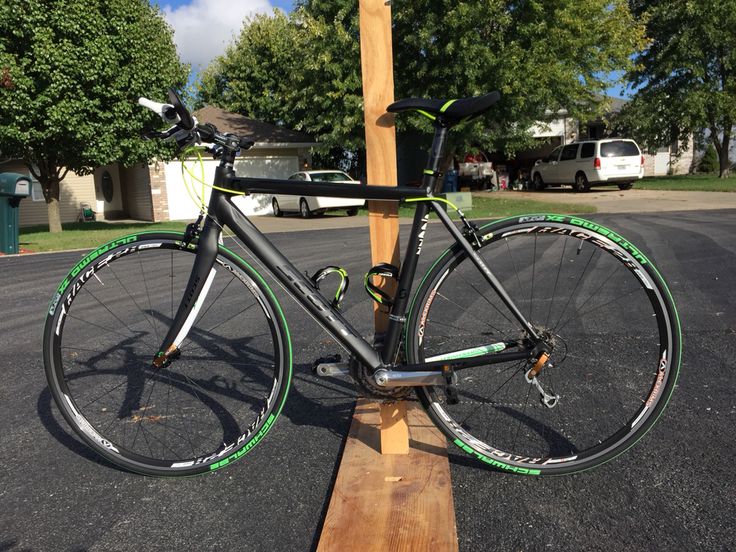 “You can end up with a really protected sidewall and little help under the tread.”
“You can end up with a really protected sidewall and little help under the tread.”
While it’s tempting to get the most mileage that you can out of your tires, pushing the limits of their lifespan will inevitably end in a flat. Mileage can range from 1,000 to 5,000 miles and varies by tire type. Even if you don’t track your mileage, you should replace a tire if it has dry rot or if the threads are visible.
Now 15% Off
$7 at Amazon
Credit: Slime$7 at Amazon
Credit: Kenda$15 at Amazon
Credit: Johnson and JohnsonNow 42% Off
$35 at Competitive Cyclist
Credit: ContinentalThis might be an obvious tip, but many don’t take the time to do it. If you think you’ve ridden over a patch of glass, grit, or any other sharp objects that litter the road, just stop and inspect your tires for foreign objects.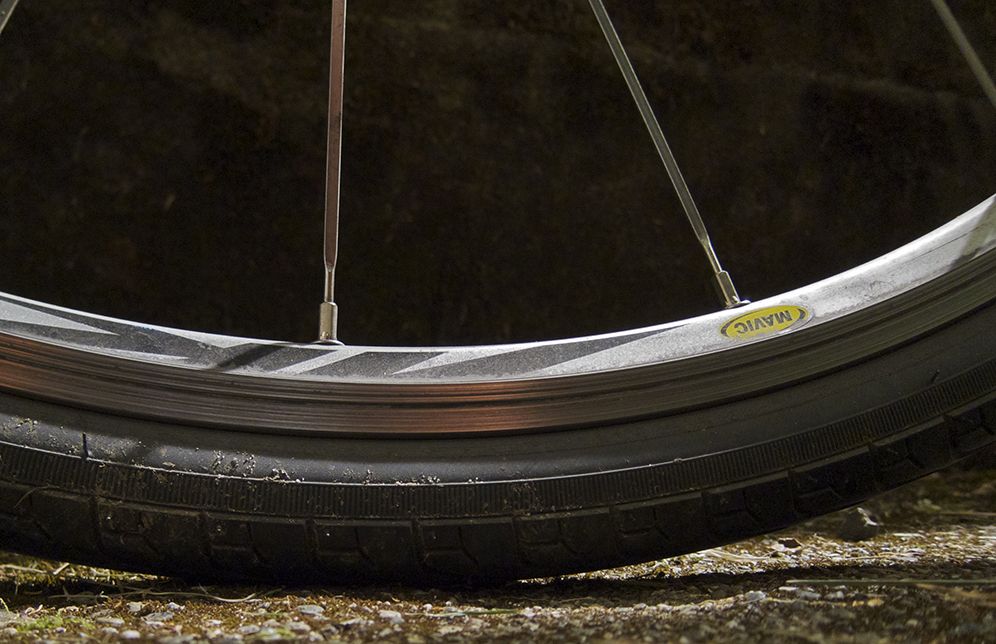 If you see anything embedded in the tire, gently pry it out. If you have a handkerchief, bandana, or glove, use it to protect your hand while you gently spin the wheel, and see if anything gets caught on the cloth.
If you see anything embedded in the tire, gently pry it out. If you have a handkerchief, bandana, or glove, use it to protect your hand while you gently spin the wheel, and see if anything gets caught on the cloth.
Trevor Raab
This step can prevent an embedded object from causing a puncture later if it hasn’t already pierced the tire’s casing. It’s good practice to inspect your tires after each ride, too.
They’re harder to find as their popularity has dropped off, but tire wipers are still a great way to prevent punctures (though they only work on tires with minimal tread). Tire wipers attach to your rim brakes or fenders and consist of a rubber-coated metal bar that lightly rubs the tire as it rotates to wipe away debris before it has a chance to puncture the tire.
Trevor Raab
That spare tube in your saddlebag could be a lifesaver on a long ride, but wouldn’t it be a bummer if you changed a flat, only to discover that the tube was no longer good? Make sure your bike’s inner tubes are in good shape when you need them by avoiding these common mistakes.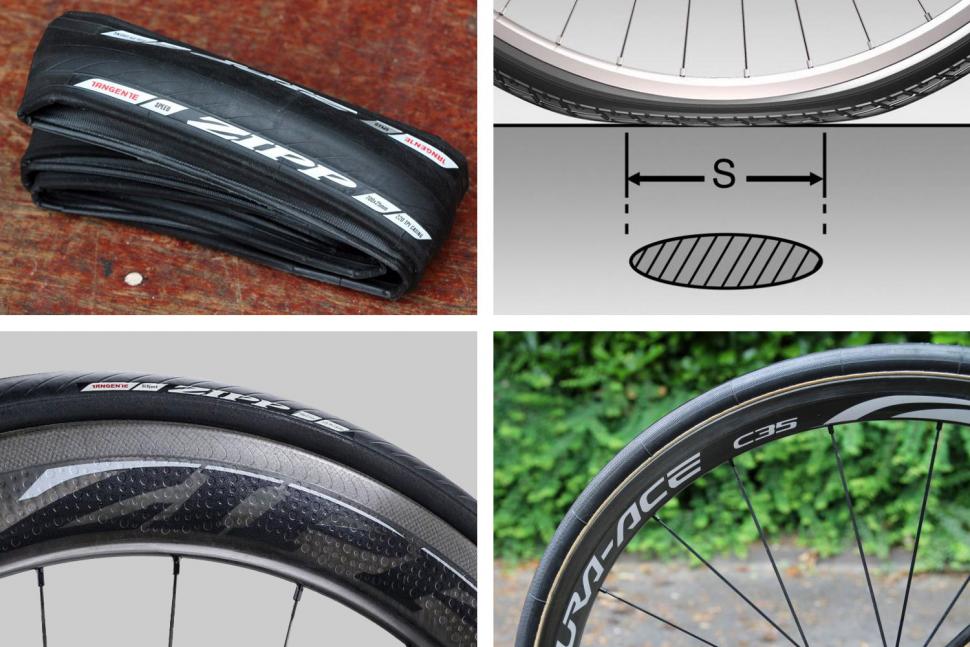
Maybe you’ve been fortunate enough to evade flat tires for a while. If that’s the case, the spares in your saddlebag might need to be replaced. Storing tubes inside a saddlebag for long periods of time can lead to weakness or cracks where the tubes are folded. The tubes can also be damaged by jostling against other items in the bag. Unpack your tubes occasionally to prevent them from cracking or splitting. If in doubt, inflate them to look for leaks.
This is especially important for Presta-style valves, which are particularly pointy. Make sure the valve is capped when you fold up the tube for storage so the valve doesn’t poke a hole into the tube.
Over time, rubber bands could react with the rubber of the tube and cause a hole to form. The rubber band could even fuse to the tube and create a tear when you try to separate them. It’s best to keep your tubes in their original cardboard box or in a plastic bag.
The rubber band could even fuse to the tube and create a tear when you try to separate them. It’s best to keep your tubes in their original cardboard box or in a plastic bag.
Heat degrades the rubber, making it brittle and less elastic. If you have tubes you’re not planning to use for a while, keep them away from direct sunlight and especially from a heater.
Jessica CoulonService and News Editor
When she’s not out riding her mountain bike, Jessica is an editor for Popular Mechanics. She was previously an editor for Bicycling magazine.
This content is imported from OpenWeb. You may be able to find the same content in another format, or you may be able to find more information, at their web site.
By Bob Forgrave
President, Flatbike
It’s a sunny day, you’ve got the time off, your bike is calling you…and it’s got a flat tire. And the bike pump is … somewhere. If this has ever kept you from getting out on a bike, then here’s exactly what you need. Here, on one comprehensive page, are five ways to thorn-proof your bike, from the simple to the hilariously expensive…
And the bike pump is … somewhere. If this has ever kept you from getting out on a bike, then here’s exactly what you need. Here, on one comprehensive page, are five ways to thorn-proof your bike, from the simple to the hilariously expensive…
A few weeks ago, I got a call from Randy, a private pilot who likes to fly his CHANGE folding mountain bike into remote places for exciting adventures in his private plane. He wanted tips on how to avoid thorn flats.
How remote? And what kind of vegetation are we talking about?
Cacti in West Texas can have some awfully long thorns…
Those are some serious spikes. And West Texas cacti aren’t the only problems. Blackberries, devil’s club, goathead thorns, ‘wait a minute’ vines…nearly all parts of the country have some species that are unfriendly to inflated tires.
Basically, if you know you’re headed into thorn country, there are five different ways to address the issue of puncture flats.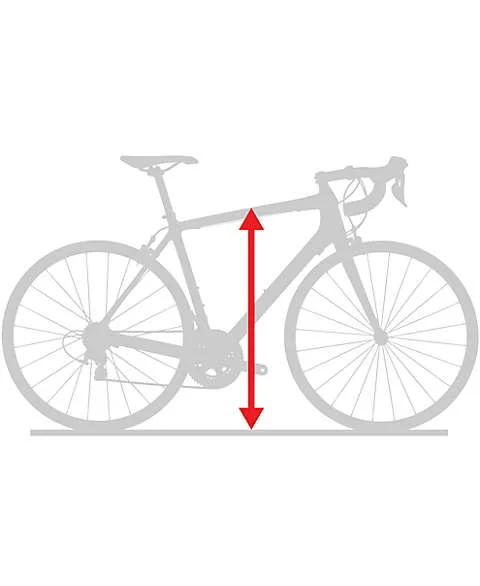
Tires and inner tubes come in thicker, thorn-resistant versions, which are tougher for thorns or broken glass to puncture. Why don’t all bikes come like this? Because extra rubber results in extra weight. How much do you want to free yourself from flats?
Using a set of these in the 80’s, I once went over 2,000 miles between flats; when I finally got one, it was from a thumbtack inserted in the sidewall at a bike rack. Even the best intentions won’t stop everything…
The Specialized Armadillo tire series has different levels of rubber thickness, with more thickness protecting more, but also offering a bit stiffer ride. The Continental Gatorskin, on the other hand inserts a layer of Kevlar clear around the tire to protect against anything–perhaps even sidewall thumbtacks.
Kevlar: If it can stop bullets, it can stop thorns.
You can also protect against thorns at the inner tube level.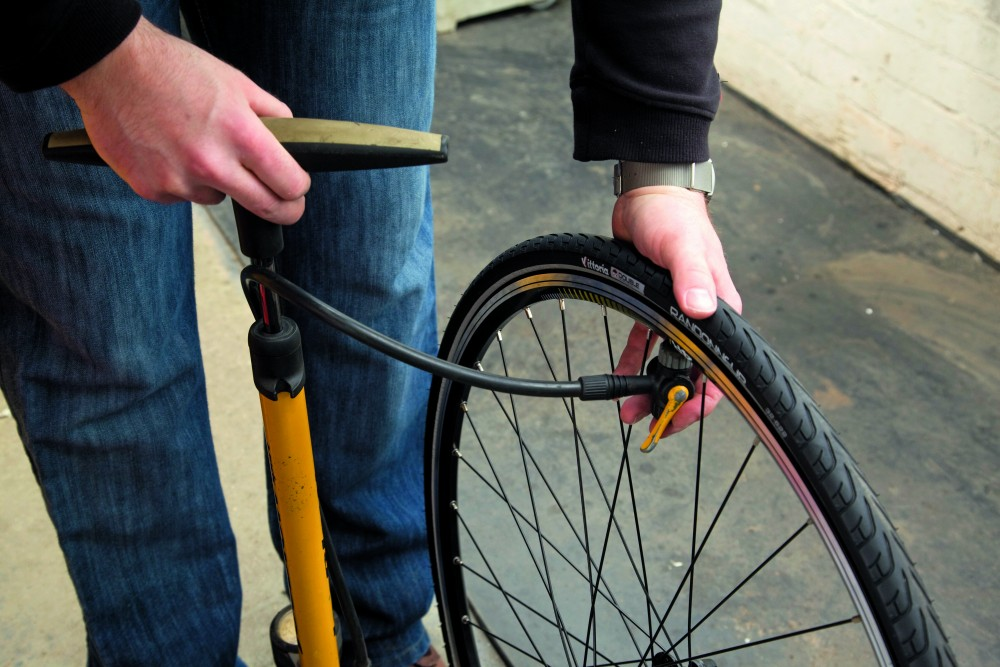 But thicker tubes are becoming harder to find in recent years.
But thicker tubes are becoming harder to find in recent years.
Kenda owns a large portion of the thorn-resistant tube market.
FLATBIKE ASSESSMENT: Good, easy plan. We include Continental Gatorskin flat-resistant tires standard on our Flatbike Century folding road bike.
The idea is simple. A small amount of liquefied goo stays inside your tire. When you get a puncture and the air starts leaking out, the goo rushes to the opening and clogs it.
In practice, this often works, especially if the hole is small enough, the hole is on the bottom of the tire, and the self-sealing compound in your tire is recent enough to be still liquid.
Otherwise, you end up with this inside your tires (The “tire coral”, not the money).
If you go with this approach, you probably want a tubeless tire, because there’s simply no way to change the liquid inside an inner tube. Notable self-sealing solutions are Slime and Stan’s. The website MBAction has a great review of these and other sealant solutions, with the wonderful testing warning, ‘All tires were harmed during the testing process.’
Notable self-sealing solutions are Slime and Stan’s. The website MBAction has a great review of these and other sealant solutions, with the wonderful testing warning, ‘All tires were harmed during the testing process.’
FLATBIKE ASSESSMENT: Wait & see. Some folks swear by the tire sealant approach, and we’re interested to hear from you. But a tubeless tire works best with a compatible rim. Useful extra aids are a bucket of soap water, a sponge, and an air compressor. And after that, we wonder if the time previously spent fixing flats on the road is simply transferred to garage maintenance, installing and removing old filler.
For a while, before my thorn-resistant tires, I rode a 1980’s technology, solid rubber tire. Potholes were memorable on my spine, but traction was good and I never got a flat.
On the surface, an update to this approach sounds appealing. Flat tires are the #1 maintenance issue bringing customers into many bike shops.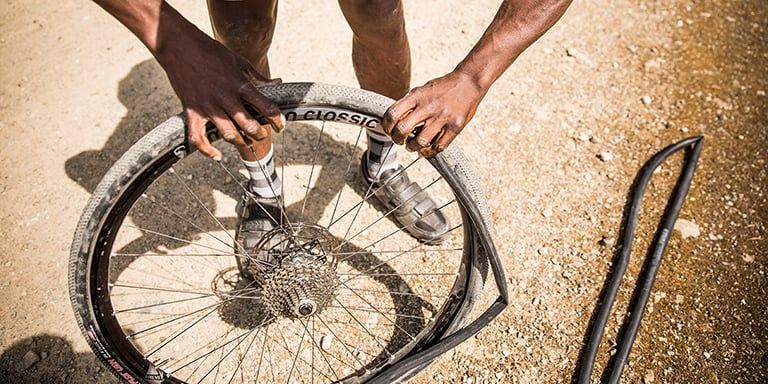
That said, compressed-air tires distribute a shock across the entire rim, while solid tires distribute stress only locally. And some bike shops charge a premium for replacing a solid tire. Has advanced technology made a difference?
With today’s advanced polymers, there are more options and better options than ever. One example is the Tannus Airless Tire. Made of closed-cell polymer foam, it is reportedly as light as most tire/tube combos, good for over 5,000 miles and comes in 12 stylish colors. Tannus even claims equivalent rolling resistance to inflated tires.
No more flats. Ever.
During Bike Expo NY 2018, a Tannus rep offered to put a set of Tannus airless tires on a CHANGE 702 folding commuter bike, which I then rode in the 40-mile Five Borough Tour, plus another 20 riding to and from the event.
After a 60-mile day, I must say that the difference between the solid rubber tires of the 1980’s and the carefully calibrated polymer tires today could not be more stark. Even a cobblestone road was possible at 15 mph–still not fun on narrow tires, but the choice of tire composition was never in question after the first few wheel rotations.
Even a cobblestone road was possible at 15 mph–still not fun on narrow tires, but the choice of tire composition was never in question after the first few wheel rotations.
Among the joys of that 10-mile pre-ride was a surprise section on this road. It felt just like a regular air tire!
FLATBIKE ASSESSMENT: Airless tires will remain more difficult to install/uninstall than inflated tires. But not by much, with the right tool. And it’s a one-time deal.
Last we’ve heard, there’s also about a 5% loss in rolling efficiency. If you keep your tires fully inflated all the time, pumping up for every ride, these aren’t for you. But if you often go weeks between fill-ups, adding 20 lbs or more when you fill up, then you’re going to experience an increase in rolling efficiency. We’ll continue to explore this area as it matures.
4. Like solid tires, but not.We got this tip from a reader–thanks, Donny–and it has developed into a brilliant idea that’s worth a category all its own.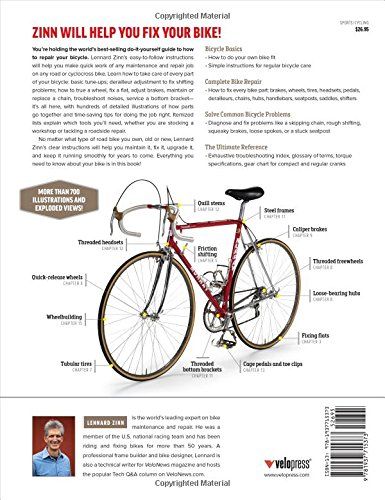 But first, let’s take a step back and look at what riders (road and MTB) actually do with their tires.
But first, let’s take a step back and look at what riders (road and MTB) actually do with their tires.
Road riders have a preferred pressure that must be maintained over time for maximum efficiency. They rack up many miles on pavement that may occasionally have a pothole, broken bottle, or goathead thorn. Under low pressure, ‘pinch flats’ may also occur, without any obstacle in the way.
Goathead thorns: Nasty stuff.
MTB riders, on the other hand, vary their terrain–one day dirt trails, another day lots of bumps and big jagged rocks–so their tire pressure varies accordingly. The rockier the terrain, the more pliable you want your tire to avoid punctures and increase grip. Broken glass isn’t usually an issue, but goathead thorns and cactus thorns are worse.
So while an airless tire might make sense for a road bike rider, it would take away the ability for MTB riders to adjust pressure for different terrain. Enter a new category: the tire liner.
A tire liner goes between your tire and innertube, protecting against puncture.
A tire liner can be inexpensive. The one shown here from Mr Tuffy is just ten bucks, with a 70% satisfaction rating. Folks have ridden over 1000 miles with it, and even ‘successfully’ run over broken glass. (And “Ed” in the comments has an even cheaper solution that may be more reliable.)
But it’s still not flat-proof. And you can create your own flats, both from semi-inflated tires (pinch flats) and from having your rim liner slide to the side and rough edges puncture your inner tube (anyone have a name for that?). And tire liners are no match for goathead thorns.
Now here’s where it gets really interesting. Suppose you took the inflated tire idea, and the foam solid tire idea, and the liner idea, and melded them together into a single product that inflated but was thick enough for goathead thorns?
Tannus Armour: an MTB-focused liner that’s finally designed for goathead thorns.
The Tannus Armour is a special type of liner–the red part–with 15 mm of the Tannus solid-tire material under the tread of the tire, and 2mm on the sides. It’s like having most of the advantages of an airless tire, plus the ability to adjust pressure to your terrain.
Normally, this is a ride-ending disaster. Not with Tannus Armour.
Even in the worst case scenario, with a random goathead thorn doing a stealth insertion from the side that goes through tire, 2 mm liner, and inner tube, giving you a flat…you still have 15 mm of solid tire to ride back on, protecting your rim from rock damage.
FLATBIKE ASSESSMENT: We cannot pass this up. We are now offering Tannus Armour at Flatbike, both separately and as an add-on to our our full-size folding mountain bikes. We now offer Tannus Armour for 20″, 26″, and 27.5″ wheels.
5. And now for something completely different…
What if price were no object, and you could just optimize for the ride on your own wheel? This is the idea behind the Energy Return Wheel.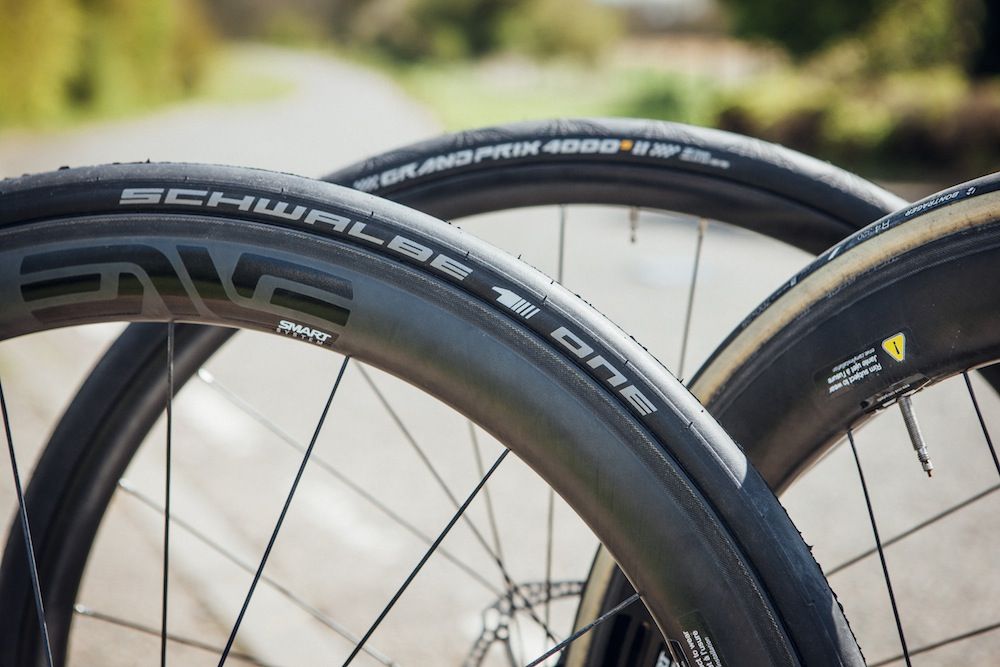
According to company literature, not only does this completely flat-proof option perform as well as a standard mountain bike wheel, but it outperforms a standard wheel, particularly on uphills. Available for the low, low price of just $2,699 from EnergyReturnWheel.com.
FLATBIKE ASSESSMENT: Hmmm. That’s…different. Can we still afford the rest of the bike? And do we have to clean the insides of the tires after a ride?
Overall, that’s five different ways to solve the flat-tire problem. Which one works best for you?
See you on the trails!
[email protected]
425-985-6219
Probably everyone who rides a bicycle has punctured a wheel at least once. This is an unpleasant, troublesome and even a little insulting business. The most interesting thing begins when the puncture occurs far from civilization, and you did not take anything with you except water.
Progress, however, does not stand still and offers us many solutions to this problem, which in August, by the way, in some regions, becomes a natural disaster. It's all because of the season of flowering "thorns". However, you can pierce in any other way. There are far more of them than there are ways to deal with them.
It's all because of the season of flowering "thorns". However, you can pierce in any other way. There are far more of them than there are ways to deal with them.
In general, there is a problem - there are solutions. We will share with you 11 ways to deal with bicycle tire punctures.
The method indicated under number 1 works flawlessly. It works at any time of the year and deprives the cyclist of a huge amount of hassle associated with patching the tubes. Deprives the method and the title of a cyclist. So, if this method does not suit you, then move on to point 2.
Sealants vary in price, quality and composition. For road tires, he is one so that he can work at high pressures. For MTB tires, it is completely different, there are fewer requirements for it. There are sealants for chambers, and there are also sealants for tubeless tires. They differ from each other in composition and permeability.
Sealants are water based and contain filler. In some compositions, it is made as a small rubber crumb, in some compositions it is a small pile.
When a wheel is punctured, the sealant will flow through the puncture, dragging the filler with it. He, in turn, covers the hole, making its area smaller. Then the composition of the liquid begins to act, it thickens and turns into a kind of rubber. The wheel in this scenario will lose some amount of pressure, but in practice it often turns out that it does not have time to go down too noticeably and the rider only knows about the puncture in the parking lot when he sees a wet spot on the rubber.
In practice, if, after a couple of years of operation, the sealant is drained and the wheel pumped up, it turns out that it looks like a sieve. There will be a lot of holes. You should not worry while you are driving, none of them will make itself felt. Even a simple bicycle will not affect the manifestation of punctures. But the release of all the air and re-inflating the next day will show everything.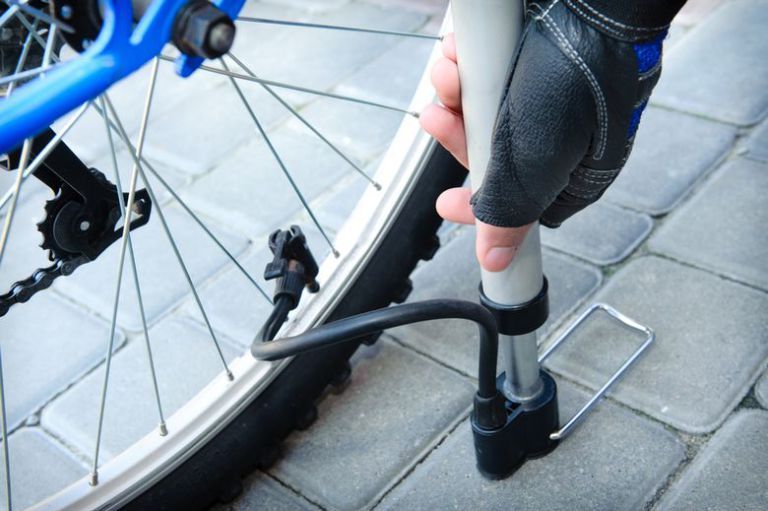 Although even here it is enough to turn the wheel so that the sealant spreads and stops all leaks.
Although even here it is enough to turn the wheel so that the sealant spreads and stops all leaks.
If you haven't switched to anti-puncture tires yet, it's a good idea. They give a feeling of calm on the road for years. Yes, years without punctures and without restriction in movement. It happens, I assure you.
Anti-puncture rubber does not differ from ordinary rubber in composition. She is exactly the same. Although it is worth noting that puncture resistance responds to the extra weight of the tire, this cannot be avoided. The fact is that an additional layer of puncture-resistant material is built into the treadmill. This is not to say that it is impossible to break through it. Everything is possible. However, the penetration of the wheels drops sharply after installing such tires.
Protection, of course, is different and depends on the discipline in which the tire is used.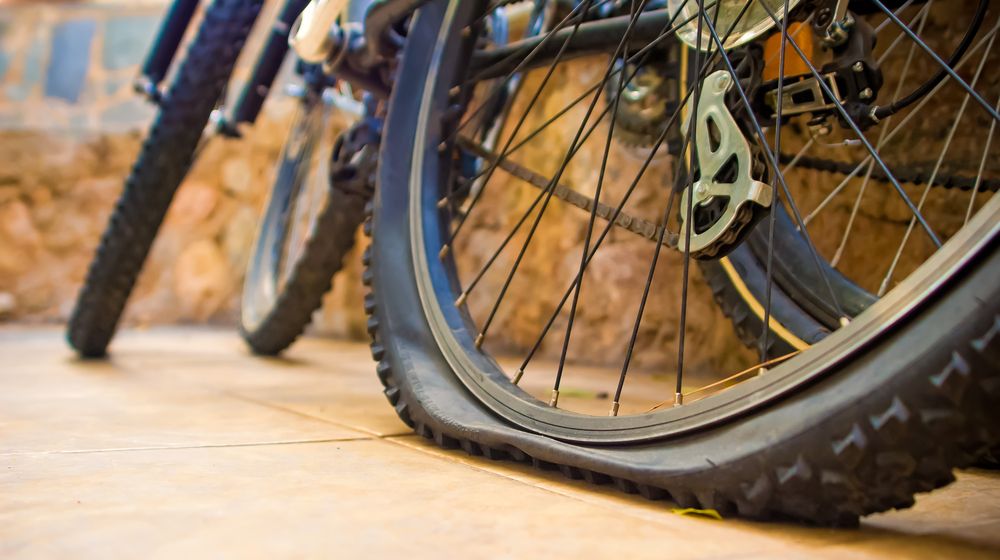 There are many weight and thickness requirements for racing road wheels, puncture resistance is good, but inferior to cruise tires. The latter weigh 5-7 times more than the road ones, also due to good puncture protection. Protection is located not only on the treadmill, but it is also on the sidewalls, although not all models have it.
There are many weight and thickness requirements for racing road wheels, puncture resistance is good, but inferior to cruise tires. The latter weigh 5-7 times more than the road ones, also due to good puncture protection. Protection is located not only on the treadmill, but it is also on the sidewalls, although not all models have it.
Motorcycles and automobiles have long made the transition to tubeless tires. Bicycles also pass on them. So far, not very fast, although positive dynamics is developing from year to year.
The advantage of tubeless tires is that there is no tube that gets punctured.
No, of course, the tire itself still breaks through and threatens to reduce the pressure to zero. That is why sealant is poured into bicycle wheels. That is, if a puncture occurs, it immediately clogs the hole. Not any, yes, but it clogs! The technology of tubeless tires and rims for bicycles is becoming more accessible every day. There are on sale both rims without holes for the spokes on the inside, and kits that allow you to make a tubeless rim from a regular rim. True, the rim walls must still be prepared for tubeless mode.
True, the rim walls must still be prepared for tubeless mode.
Personal experience tells me that if you want, you can use even a regular tire tubeless, only very carefully and patiently. She will need to be given some time to seal the pores over the entire area.
Cars and motorcycles run without sealant. If a puncture occurs there, then to eliminate it, there are special kits made of a “worm” of raw rubber and an awl, with which the “worm” is inserted into the hole. I think it would work on a bike too.
Do not rush to condemn us for this way of dealing with punctures. We are talking about replacing the camera from butyl rubber with latex. The latter is very elastic and less prone to punctures. This means that when in contact with a sharp object, the camera tries to “hug” it without piercing. Such a camera will not provide full protection against punctures, but it will simplify life.
 Buy
Buy On the other hand, latex cameras are also famous for the need to constantly pump up. That is, a butyl chamber needs to be pumped up, for example, once every two or three weeks, and a latex one every two or three days. Such is their feature. Another option concerns conventional butyl chambers with sealant inside. Such a chamber can be purchased ready-made, or you can download sealant into a regular chamber. It doesn't change the essence.
These are tires that do not have a void inside. I remember such tires from childhood, they were on a tricycle. Yes, in general, they are used in many places.
Tannus is a bright and almost the only representative of such tires for bicycles. Their product allows you to completely forget about the pump and just enjoy the ride. Of course, you have to pay for such a solution with difficulties in wheel beading and rigid wheels, the pressure of which cannot be adjusted to the conditions of the road surface.
Contrary to popular belief, low pressure tires are more prone to punctures. Well-inflated wheels, on the other hand, are highly resistant to punctures. The biggest danger in flat tires is the possibility of a snakebite puncture. It happens when you hit a curb, for example. The tire is crushed, and the chamber inside is clamped between it and the rim. It turns out two points of contact with the rim, and hence two punctures, which are almost impossible to seal in practice. That is, you will put the patches, but the pressure of the camera will still start tearing further or simply undermine the patches.
In order to inflate the wheels correctly, you must have a pressure gauge and carefully read the information on the sidewall of the tire. The minimum and maximum tire pressures are always listed there.
By the way, we wrote a separate article about the air pressure in bicycle tires, we recommend that you read it.
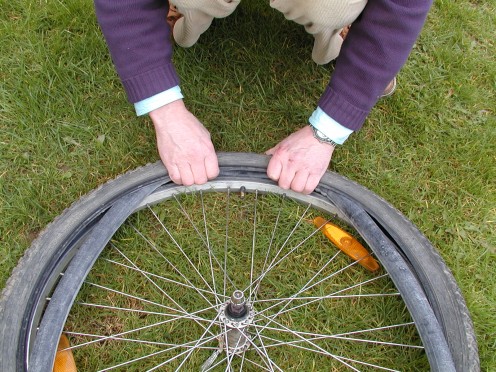 Check tires for wear
Check tires for wear Worn tires puncture more often. The fact is that the thickness of the rubber becomes smaller, it becomes easier for sharp objects to reach the inside of the wheel. So... check your tires often, then you will be able to see in advance pieces of glass that are stuck or thorns that have not yet had time to completely break through the tire.
Tire wear is most pronounced, in the context of punctures, on MTBs. Everything is obvious here - the high tread simply did not allow the base to touch the ground. When the tread is worn down to 0, then the base is already affected by sharp objects.
Plus, you'll always know when to change your tire.
Try to keep your eyes on the road. More precisely, if, then for its purity. The presence of glass and other artifacts should send you on a different trajectory.
It is safest to drive on a car track, not on the side of the road. Again, we are talking about security in the context of punctures.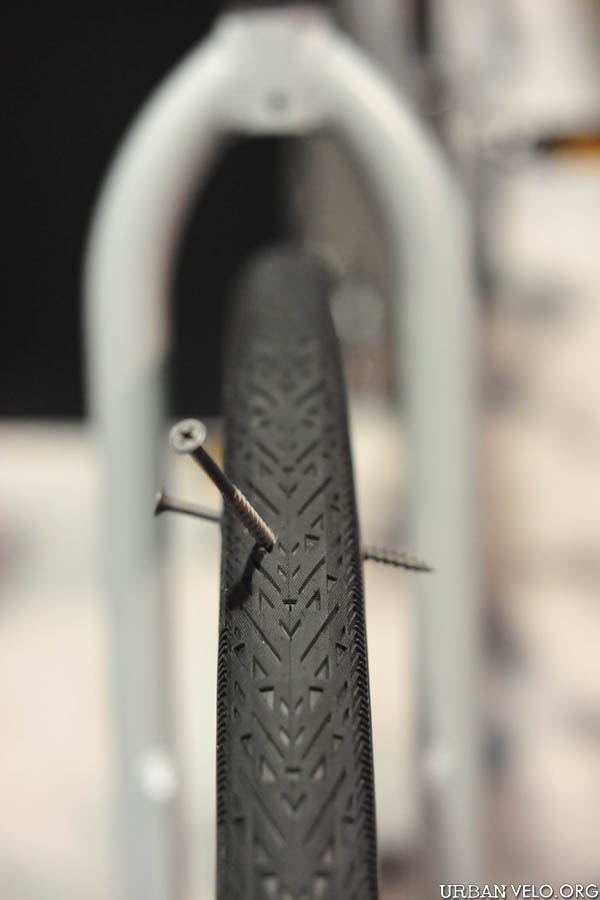 From the point of view of traffic safety, it is more expedient to drive along the side of the road, where, by the way, there are more than enough sources of puncture.
From the point of view of traffic safety, it is more expedient to drive along the side of the road, where, by the way, there are more than enough sources of puncture.
Water acts as a lubricant for objects that aim to penetrate your tire. I don't know what else to add here. Is that information about the article, where we talk about actions in case you get caught in the rain.
You'll have to go to a bike shop and buy yourself a set to patch your tubes on the road. Modern sets are the size of a matchbox, so there is room for it. The situation is worse with pumps. They are bulky. No, well, there are, of course, very small ones ... I have one of these. I tried to pump a road wheel with it. Once. Do not want anymore. It does not give pressure and it takes an incredibly long time to pump, but it is only 10-15 cm long and has a built-in hose, which is very convenient on the road.
Full name
Borik Vladimir
Passionate cyclist since 2014. He could not stand it when the bike made extraneous sounds in motion, which made him go over everything, re-grease and renew it many times. He likes to delve into the subtleties, therefore, numerous bulkheads of his bike later turned into a job as a bike mechanic. I went from Shimano Acera to Comance Tomahawk through SLX to XTR to Specialized S Works, and then just switched to a budget road bike on Campagnolo Xenon 10 equipment. Kuyalnik 2019 bike marathon (MTB) behind-year, where Light took 5th place on the route. Currently remains an active bicycle user and continues to deepen his knowledge in this area.
Tire punctures are common for cyclists and at the same time a nightmare on the race and a spoiled mood on a bike trip.
Fortunately, there are steps you can take to reduce the risk of a puncture. Our tips will help you avoid an unpleasant situation.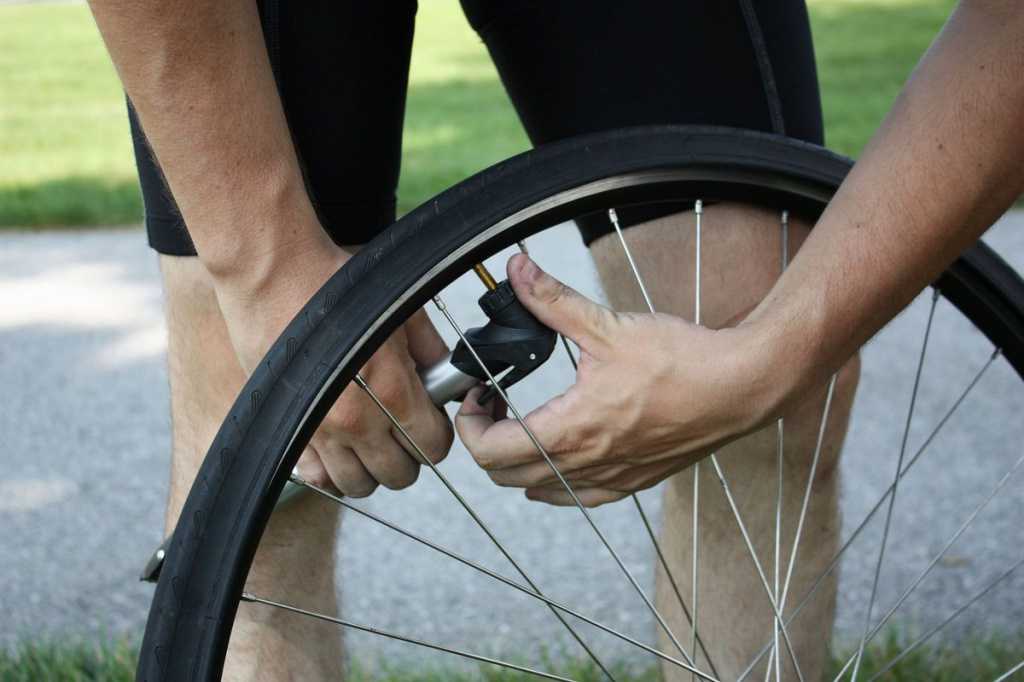
Bicycle tires are what protect your camera. The lightest and fastest tires are also the most prone to punctures.
Tough and durable marathon tires have a tough, puncture-resistant layer that helps prevent sharp objects from penetrating the belt and tube. Yes, they are heavier, but the repair of the wheel has a stronger effect on the results of the race in a negative direction.
Often the cause of a puncture, puncture or snakebite lies in insufficiently inflated tires. "Snake bite" occurs when a sudden collision with something protruding (curb, stone). In this case, the camera breaks in two adjacent places. Due to the weak pressure in the chamber, the tire bulges, pressing against the rim, and the chamber is sandwiched between the rim and a solid object on the road.
To avoid this kind of trouble, make sure your tires are properly inflated before riding, especially if you're on a less than perfect track.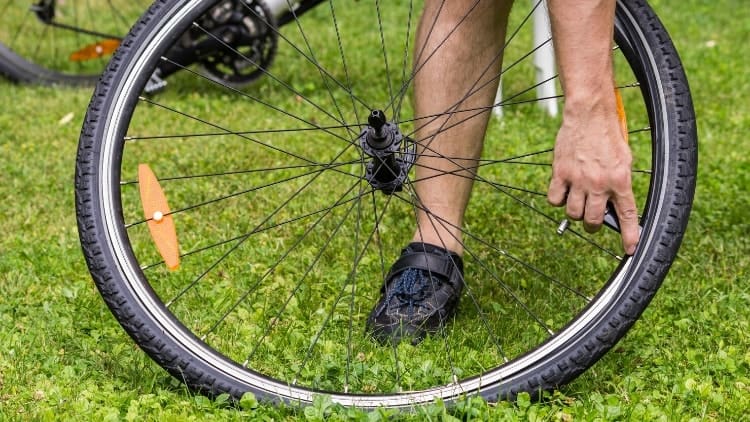 Properly selected pressure gives less chance of deformation of the tire and its contact with the rim.
Properly selected pressure gives less chance of deformation of the tire and its contact with the rim.
The tire must be marked with the values to which it should be inflated. Try not to go beyond both the minimum and maximum values. If you are going to ride on asphalt, bring the tire pressure to the maximum value, and if on an uneven surface, reduce it to the average allowable.
This simple tip is ignored by many, unaware that before and after every ride you need to spin the wheels and check for any sharp objects stuck in the tyre. If they are not removed, they will over time, under the influence of your weight, push into the inner chamber - and provide a puncture.
Most glass and debris collects on the edge of the road, so another way to protect yourself from camera repair is to choose a place on the road away from littered areas.
 Watch the road
Watch the road Don't just look under your wheel, otherwise you risk not noticing a pit, stone, broken glass and other dangers in time. Look a few steps ahead.
If you are traveling in a group, warn your comrades of the danger. There are special signs for this. If someone has a puncture, the whole group will have to wait on the side of the road until the injured cyclist is done with the repair.
If you cannot avoid a potential hazard, loosen your grip on the handlebars as much as possible and try to "slide" over the obstacle. When you tense up by squeezing the steering wheel and leaning on it, the force acting on the front wheel in the event of an impact increases.
In addition, you can use your cycling skills to literally jump over obstacles. This works well with potholes, rails, and narrow artificial bumps like speed bumps. Just don't show off your amazing skills when riding in a group.
If you do need to replace tubes, always check the inside of the rim and tire for any debris.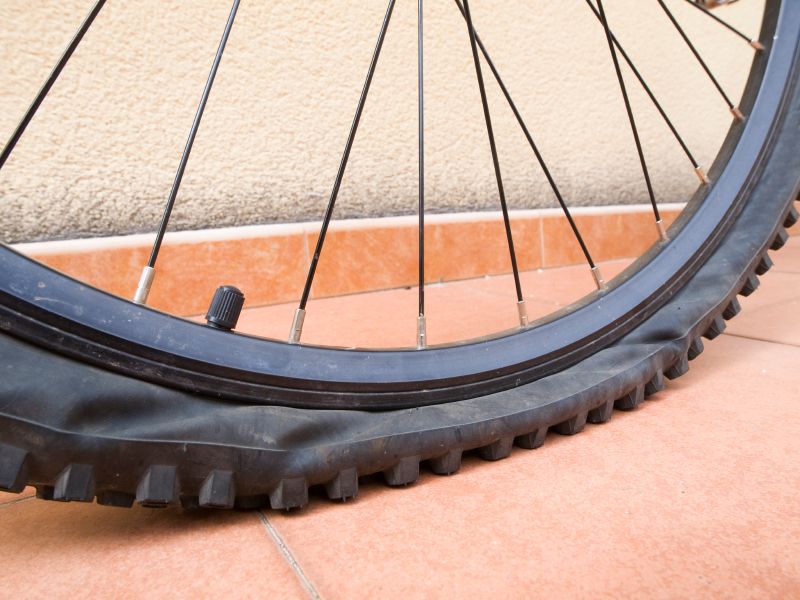 To do this, carefully run your finger along the inner surface and inspect.
To do this, carefully run your finger along the inner surface and inspect.
Then inflate the inner tube a little, place it in the rim support and make sure that the inner tube does not get stuck between the rim and the edge of the tire.
Tubeless tires don't have the usual tube underneath, hence the name. Tubeless technology has been around for many years, especially in the mountain bike market. Gradually, it is being introduced into the road cycling environment. "Tubeless" have increased resistance to punctures and here's why:
Tires don't last forever and wear out over time. Many of them have an indicator showing when it's time to replace.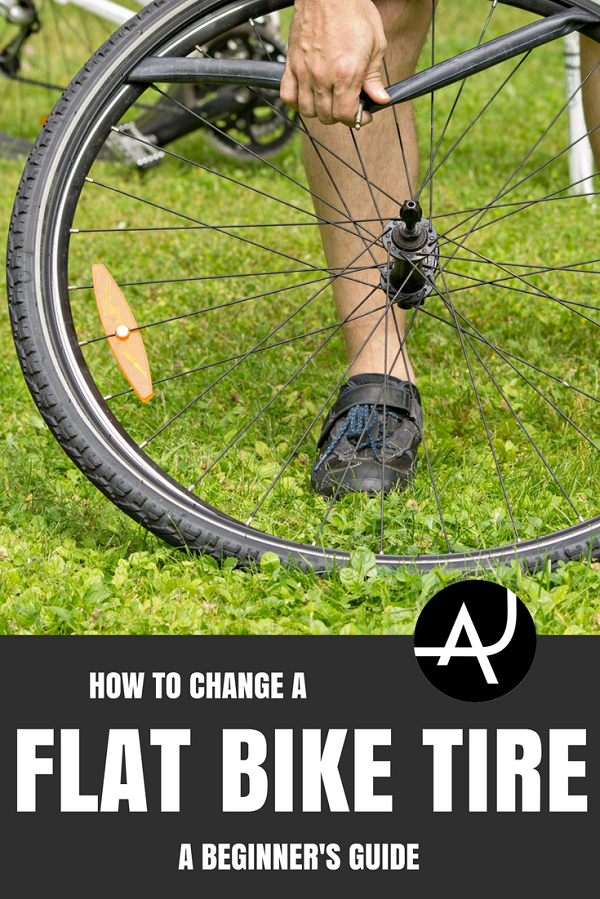 As soon as it shows up, get a new tire.
As soon as it shows up, get a new tire.
Indicators are usually two small holes a few mm wide in the tire tread. If they are no longer visible, then the tire has worn out, and it is time to change it.
There are no such indicators on the MTB, but you can watch the tread spikes. When they get rough and close to being level with the ground, it's time to install a new tire.
Sometimes the problem is not on the outside, but on the inside. For example, in the rim. So, the rim is surrounded by a rim tape, which can be damaged or move. This is the most innocuous of problems, and if you find worse faults, visit a bike shop where they will fix your wheel.
Of course, it is not expected that a puncture will be the fault of the old chamber, but it happens. The inner chamber also wears out, and the rubber becomes more crumbly. If you haven't changed your camera for several years, check it before an important start.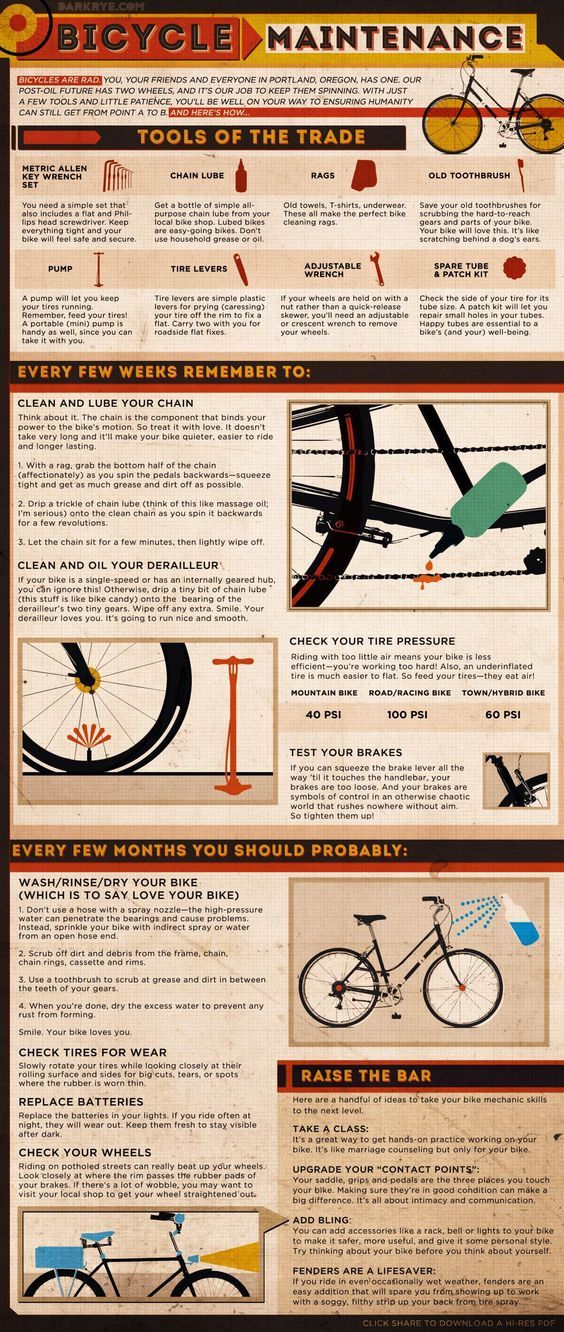
Although there is a belief among riders that with a new tube a puncture will happen literally on the same day.
Taping a punctured tube is a cheap but temporary solution. With a camera that has a patch, and even more so more than one, the risk of a puncture increases. If it is not possible to install a new camera on the way and you have to patch a punctured one, we recommend that you replace it immediately after the trip.
This tip is for cyclists who ride without punctures for a long time. The chamber valve itself and the place around it wear out faster than rubber. During the year, you have to pump up the wheel countless times, so sometimes the culprit of a flat tire on a trip is a valve damaged from use.
The area on the tube around it can also tear and crack, because it is most subject to friction against the hole in the rim.
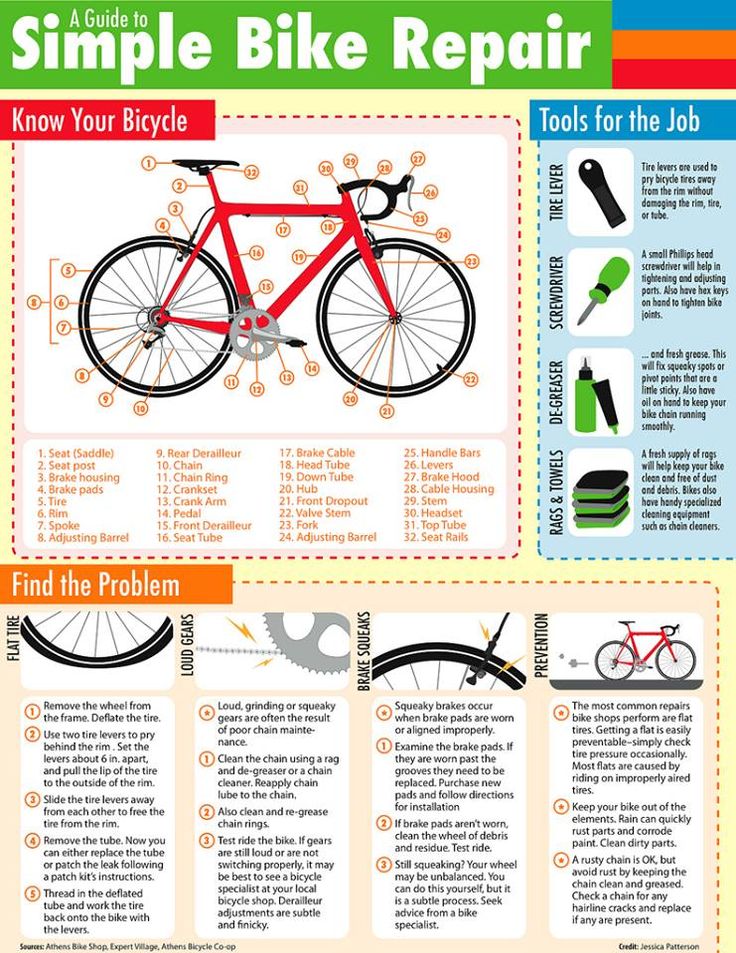 Don't ride in the rain
Don't ride in the rain When it rains, you're more likely to get a puncture because the water acts as a lubricant and helps sharp stones and glass cut through the tire. And when it rains, there is more garbage on the road: it is washed from sidewalks, lawns and from the edge of the road to the part where you usually ride a bike.
Sealant can be used in more than just tubeless tyres. This tool is added to conventional cameras. It, of course, will make the wheel a little heavier, but it will create additional protection.
Adding sealant is easier if the chamber has a removable valve core, so you can fill it without risking clogging the valve. But before you follow this advice, make sure the sealant is compatible with your bike's inner tubes, especially if you're using latex ones.
Inner tube sealant works the same as tubeless sealant. It covers the inside of the chamber as the wheel spins, and if you puncture, the air escaping from the chamber sucks the sealant towards the hole.